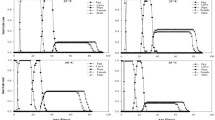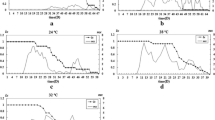Abstract
Anthocoris minki Dohrn is a promising indigenous Anthocoris species for the biological control of Agonoscena pistaciae Burck. and Laut. (Homoptera: Psyllidae) in pistachio orchards in Turkey. The adult longevity, fecundity, life table parameters and prey consumption of A. minki fed on Ephestia kuehniella Zeller (Lepidoptera: Pyralidae) eggs were studied at combinations of three constant temperatures (20, 25 and 30 ± 1°C) with two relative humidity (RH) levels (40 and 65 ± 5%). Studies indicated that temperature and RH significantly affected adult longevity, fecundity and prey consumption of A. minki. The greatest adult female longevity was 116.0 days at 20°C and 65% RH; the shortest adult female longevity was 27.5 days at 30°C and 40% RH. At all tested temperatures, the oviposition period and prey consumption of both females and males significantly decreased at low RH compared to high RH. The highest and lowest total fecundities were 276.0 eggs (at 20°C and 65% RH) and 42.4 eggs (at 25°C and 40% RH), respectively. The intrinsic rates of natural increase (rm) at 40 and 65% RH were 0.049 and 0.076 at 20°C, 0.072 and 0.096 at 25°C and 0.076 and 0.112 at 30°C, respectively. The highest mean numbers of E. kuehniella eggs consumed by females and males were 859.6 (at 20°C) and 515.3 (at 25°C) at 65% RH, respectively; the lowest were 183.3 (at 20°C) and 95.5 (at 25°C) at 40% RH, respectively.

Similar content being viewed by others
References
Al-Maroof IN (1990) Ecological studies on popular leaf psyllid Camarotoscena speciosa flor. (Homoptera: Psyllidae) in Mosul. Arab J Plant Prot (Lebanon) 8:16–20
Almatni W, Khalil N (2008) A primary survey of aphid species on almond and peach, and natural enemies of Brachycaudus amygdalinus in As-Sweida, Southern Syria. In: Proc Ecofruit—13th Int Conf on Cultivation Techniques and Phytopathological Problems in Organic Fruit-Growing, Weinsberg, Germany, 18–20 Feb 2008, pp 109–115. Available from http://orgprints.org/13654/
Anderson NH (1962) Growth and fecundity of Anthocoris spp. reared on various prey (Heteroptera: Anthocoridae). Entomol Exp Appl 5:40–52
Birch LC (1948) The intrinsic rate of natural increase of an insect population. J Anim Ecol 17:15–26
Bolu H, Kornoşor S, Altin M (1999) Indicating the population development of nymph parasitoid and Agonoscena pistaciae Burckhardt and Lauterer (Homoptera: Psyllidae), predator Heteroptera species and their spread areas at the Southeastern Anatolia Region pistachio (Pistaciae vera L.) areas. In: Proc 4th Turkish Natl Congr of Biological Control, Adana, Turkey, 26–29 Jan 1999, pp 7–16 (in Turkish with English summary)
Brunner JF, Burts EC (1975) Searching behavior and growth rates of Anthocoris nemoralis (Hemiptera: Anthocoridae), a predator of the pear psylla, Psylla pyricola. Ann Entomol Soc Am 68:311–315
Celik MY (1981) Investigations on the description, biology, host plants and natural enemies of the important harmful species of Psyllidae family on the pistachio trees in Gaziantep and its surrounding area (Arastirma Eserleri Serisi, No. 51). T.C. Tarim ve Orman Bakanligi, Ankara (in Turkish with English summary)
DeBach P, Rosen D (1991) Biological control by natural enemies. Cambridge University Press, Cambridge
Emana GD, Overholt WA, Kairu E (2004) Comparative studies on influence of relative humidity and temperature on life table parameters of two populations of Cotesia flavipes (Hymenoptera: Braconidae). Biocontrol Sci Technol 14:595–605
Fauvel G, Thiry M, Cotton D (1984) Progress towards the artificial rearing of Anthocoris nemoralis (F.). SROP/WPRS Bull 7:176–183
Fauvel G, Rieux R, D’arcier FF, Lyoussoufi A (1994) Biological control trial of Cacopsylla pyri (L.) in pear orchards by experimental release of Anthocoris nemoralis F. eggs. I. Materials and methods. SROP/WPRS Bull 17:81–85
Foster WA (1990) Experimental evidence for effective and altruistic colony defence against natural predators by soldiers of the gall-forming aphid Pemphigus spyrothecae (Hemiptera: Pemphigidae). Behav Ecol Sociobiol 27:421–430
Horton DR, Hinojosa T, Lewis TM (2000) Mating preference, mating propensity, and reproductive traits in Anthocoris nemoralis (Heteroptera: Anthocoridae): a comparison of California and United Kingdom populations. Ann Entomol Soc Am 93:663–672
Isenhour DJ, Yeargan KV (1981) Predation by Orius insidiosus on the soybean thrips, Sericothrips variabilis: effect of prey stage and density. Environ Entomol 10:496–500
Kakimoto K, Urano S, Noda T, Matuo K, Sakamaki Y, Tsuda K, Kusigemati K (2005) Comparison of the reproductive potential of three Orius species, O. strigicollis, O. sauteri, and O. minutus (Heteroptera: Anthocoridae), using eggs of the Mediterranean flour moth as a food source. Appl Entomol Zool 40:247–255
Lattin JD (1999) Bionomics of the Anthocoridae. Annu Rev Entomol 44:207–231
Mart C, Uygun N, Altin M, Erkilic L, Bolu H (1995) General review on the injurious and beneficial species and pest control methods used in pistachio orchards of Turkey. Acta Hortic (Pistachio Nut) 419:379–385
Mehrnejad MR (2001) The current status of pistachio pests in Iran. Cahiers Options Méditerranéennes 56:315–322
Meyer JS, Ingersoll CG, McDonald LL, Boyce MS (1986) Estimating uncertainty in population growth rates: jackknife vs bootstrap techniques. Ecology 67:1156–1166
Nagai K, Yano E (1999) Effects of temperature on the development and reproduction of Orius sauteri (Poppius) (Heteroptera: Anthocoridae), a predator of Thrips palmi Karny (Thysanoptera: Thripidae). Appl Entomol Zool 34:223–229
Odum EP (1983) Basic ecology. Holt–Saunders, New York
Ohta I (2001) Effect of temperature on development of Orius strigicollis (Heteroptera: Anthocoridae) fed on Frankliniella occidentalis (Thysanoptera: Thripidae). Appl Entomol Zool 36:483–488
Parker NJB (1981) A method for mass rearing the aphid predator Anthocoris nemorum. Ann Appl Biol 99:217–223
Peet WB (1973) Biological studies on Nidicola marginata (Hemiptera: Anthocoridae). Ann Entomol Soc Am 66:344–348
Rieux R, Fauvel G, D’arcier FF, Fournage G, Lyoussoufi A (1994) Biological control of Cacopsylla pyri (L.) in a pear orchard by experimental release of Anthocoris nemoralis (F.) eggs. II. Results and discussion. SROP/WPRS Bull 17:120–124
Samsoe-Petersen L et al (1989) Laboratory rearing techniques for 16 beneficial arthropod species and their prey/hosts. J Plant Dis Prot 96:289–316
Sigsgaard L, Esbjerg P, Philipsen H (2006a) Controlling pear psyllids by mass-releasing Anthocoris nemoralis and A. nemorum (Heteroptera: Anthocoridae). J Fruit Ornam Plant Res 14:89–98
Sigsgaard L, Esbjerg P, Philipsen H (2006b) Experimental releases of Anthocoris nemoralis F. and Anthocoris nemorum (L.) (Heteroptera: Anthocoridae) against the pear psyllid Cacopsylla pyri L. (Homoptera: Psyllidae) in pear. Biol Control 39:87–95
Souliotis C, Markoyiannaki-Printziou D, Lefkaditis F (2002) The problems and prospects of integrated control of Agonoscena pistaciae Burck and Laut. (Hom., Sternorrhyncha) in Greece. J Appl Entomol 126:384–388
Southwood TRE (1978) Ecological methods. Chapman & Hall, London
Tommasini MG, Van Lenteren JC, Burgio G (2004) Biological traits and predation capacity of four Orius species on two prey species. Bull Insectol 57:79–93
Unruh TR, Higbee BS (1994) Releases of laboratory reared predators of pear psylla demonstrate their importance in pest suppression. SROP/WPRS Bull 17:146–150
Urban J (2002) Occurrence, development and natural enemies of Pemphigus spyrothecae (Homoptera, Pemphigidae). J For Sci 48:248–270
Urban J (2004) Occurrence, development and natural enemies of cecidogenous generations of Pemphigus gairi Stroyan (Sternorrhyncha, Pemphigidae). J For Sci 50:415–438
Yanik E (2006) Determination of the effects of different preys on the reproductive biology of Anthocoris nemoralis (F.) (Heteroptera: Anthocoridae). Turk Entomol Derg 30:57–65 (in Turkish with English summary)
Yanik E, Ugur A (2002) Investigations on the rearing of predator Anthocoris nemoralis (F.) (Heteroptera: Anthocoridae) under laboratory conditions and determination of some biological characteristics. In: Proc 5th Turkish Natl Congr of Biological Control, Erzurum, Turkey, 3–7 Sept 2002, pp 109–116 (in Turkish with English summary)
Yanik E, Ugur A (2004) Consumption of Cacopsylla pyri (L.) (Homoptera: Psyllidae) and Ephestia kuehniella Zell. (Lepidoptera: Pyralidae) eggs by predator Anthocoris nemoralis (F.) (Heteroptera: Anthocoridae) under laboratory and natural conditions. Plant Prot Bull 44:47–67 (in Turkish with English summary)
Yanik E, Ugur A (2005) Investigations on the fecundity of predator Anthocoris nemoralis (F.) (Heteroptera: Anthocoridae) under laboratory and natural conditions. Turk Entomol Derg 29:111–124 (in Turkish with English summary)
Yanik E, Unlu L (2010) The effects of different temperatures and relative humidity on the development, mortality and nymphal predation of Anthocoris minki. Phytoparasitica 38:327–335
Yano E, Watanabe K, Yara K (2002) Life history parameters of Orius sauteri (Poppius) (Het., Anthocoridae) reared on Ephestia kuehniella eggs and the minimum amount of the diet for rearing individuals. J Appl Entomol 126:389–394
Acknowledgments
We would like to thank TUBITAK (Scientific and Technological Research Council of Turkey, project number: TOVAG-107 O 734) for their funding support, and Dr. Abdulbaki Bilgic, Dr. Bekir Bukun and Dr. Ergun Dogan (Faculty of Agriculture, Harran University) for their help and support, as well as Galen Brunk (Colorado State University, Bioagroscience and Pest Management) for correcting the English in this paper.
Author information
Authors and Affiliations
Corresponding author
Rights and permissions
About this article
Cite this article
Yanik, E., Unlu, L. Influences of temperature and humidity on the life history parameters and prey consumption of Anthocoris minki Dohrn (Heteroptera: Anthocoridae). Appl Entomol Zool 46, 177–184 (2011). https://doi.org/10.1007/s13355-011-0029-y
Received:
Accepted:
Published:
Issue Date:
DOI: https://doi.org/10.1007/s13355-011-0029-y




